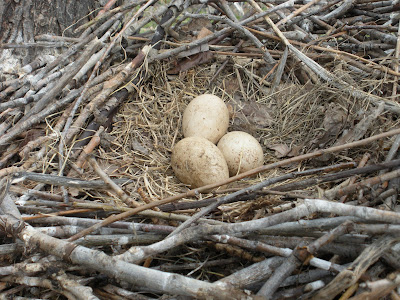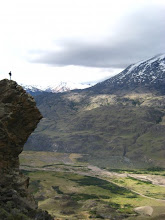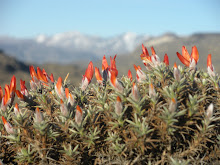As I looked over the edge of mountain, I knew there was no way we were going to be able to sneak in on the mother puma, and her kittens. The area was obviously a puma fortress with a lake serving as a mote in the front, A cliff for defense, and two well camoflauged drainages for escape.
For the past several weeks, Mark and I have consistently been looking for the tracks of Mojada, a female puma. These were needed to determine whether or not she was still taking care of two kittens or had lost one. He needs this data to determine the energy requirements of a puma, and these numbers could be affected significantly if all the cats are not accounted for.
Simultaneously, the first volunteers other than myself arrived. It was a whirlwind trip to spend two weeks in Chile, and the best they could think of was working at La Estancia. I don't think it was quite the experience they wanted, but it is really hard to have a full out experience in Patagonia without staying for an extended period of time. Because of these time limitations, we were trying to help these guys get the most out of their experience abroad. This made for a great excuse to go out and track Mojada down. Seeing a puma would totally make anyones trip.
Just looking for a puma would be very difficult, but we had an advantage with the previously captured pumas. All of the collars are equipped with a VHF transmitter which emits a signal that allows Mark to pinpoint their location. It lead us to an open grassland with some random trees, and some hills in the background. He said, "She's back in there," as we exited the truck. It was a quarter mile walk to where the puma was hiding. It seemed like it was going to be an easy venture to see these pumas, but it was quite a bit more than that. As we got closer to the site, the entrance became blocked by seemingly impenetrable terrain. A series of drainages covered in thick thorn ridden shrubs, surrounded by jagged cliffs, and an uncrossable marsh blocked our path to the puma, endangering our chances of getting to view these elusive creatures. Our best bet for getting a sighting was to walk all the way around the mountain. This was not surprising, and was almost expected considering Patagonia is all about doing things the hard way.

After we reached the potential cat site, we pin pointed the exact general location of the cat. "She's somewhere in there," Mark says. It was going to be difficult. We needed a plan. I really wanted to see the cat, but I was willing to give up a good view so these fellow travelers could possibly salvage their trip. Mark didn't want to make the decision because he didn't want to feel responsible if these guys didn't see the cat he promised. "It's always really hard when you split up into groups because half the people see the cat, and the other half doesn't." With this in mind, I came up with a plan to put the other voluteers on top of a point that would give them the best potential viewing; I sent Mark to walk up one of the other drainages, and I walked down the second drainage. We sent the other two down first to get into place, then I stepped in.

I felt like a special ops soldier. I crept through the trees as if the slightest of sounds would alert the enemy to my presence. I would wince each time the leaves crackled under my feet. As I got closer, I started hearing sounds of thuds on the ground, limbs casually being toyed with, and the occasional rustling in the grass. From what I could tell, the pumas were just enjoying a casual day of relaxation. I kneeled there for a few moments, then advanced. "How close am I going to be able to get before they know I'm here?", I thought. All of a sudden, the other two volunteers came tromping down the path that I had made, sounding the alarm for the cats to get ready to run; Well, new plan. The other two went up the hill to the right while I continued straight to the other side of a patch of trees. When I got to the other side, there was Mark, already through the drainage. I didn't say a word because he was listening to the reciever. "She's moving," he whispered. All of a sudden he spoke in a hurried tone, "She's going up the drainage," and we were off. Short sprints combined with quick stops to listen for the puma guided us through the drainage. A section of it was split by the ridge that the other volunteers were supposed to be sitting on, so I went up one side, and Mark went up the other. I was walking fast until I got to some thick scrub. A possible sixth sense told me I might be in the presense of a puma. Just then I looked up, and Mark was standing right above me on the ridge with the Telemetry. Indeed, she was right there. I looked at Mark, and he looked back with a grave expression on his face. "James, come this way...," he warned. I looked at the position I had gotten myself into, and was not very pleased. I was a mere stride away from where the puma was hiding, with no escape route due to a poorly placed rock. I quickly made it to the top of the ridge. We stood there amazed that we had caught up to her. "Once the other guys came down off their spot, and you came out of the drainage, she had an open route. I'm sure she walked right by you guys. Pumas do that; they like to play 'Cat and Mouse'," Marked confirmed. Right as he said that, he interrupted himself and yelled, "There she goes!". I didn't see her at first, but she quickly revealed herself, slinking over the top of the other ridge. "There you go James, your first puma," Mark said smiling. It was a very exciting time, but I couldn't get over how much it looked like a really big house cat. He said "Yeah, pretty much." One of the guys stopped at the ridge the lion had used to escape, and said "Did you see anything?" He neglected to see the fresh paw prints just beneath his feet. Mark told them how close they had come to the lion, and I think it may have blown their minds. In fact, it blew mine as well. I was within feet of it, and I still couldn't see it.

We left the other two to continue their hike, trying to make the most of their last day, while we walked back to the truck to have a victory cigarillo (Snickers for me). It had turned out to be a pretty good day.













